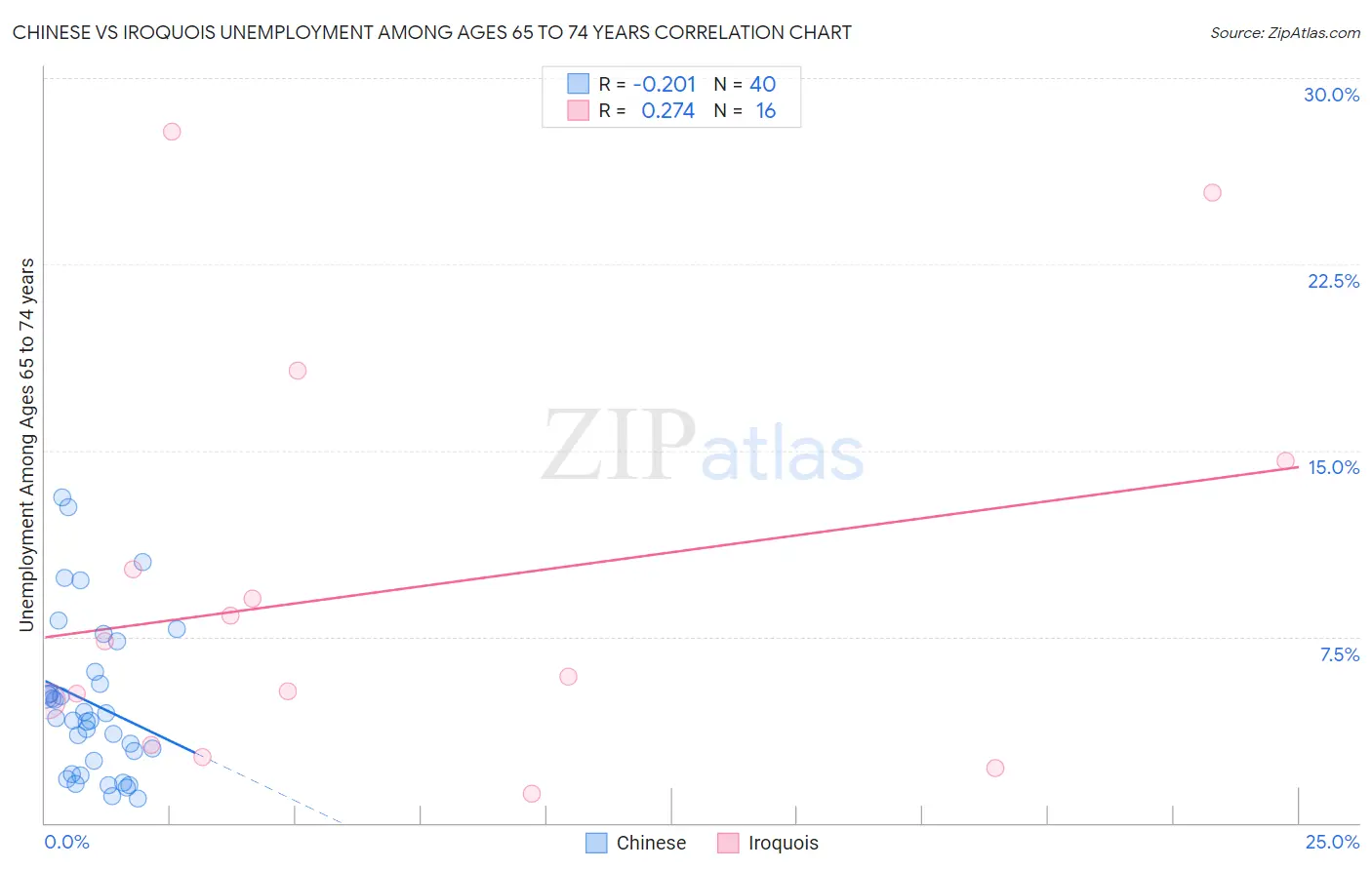Chinese vs Iroquois Unemployment Among Ages 65 to 74 years
COMPARE
Chinese
Iroquois
Unemployment Among Ages 65 to 74 years
Unemployment Among Ages 65 to 74 years Comparison
Chinese
Iroquois
4.4%
UNEMPLOYMENT AMONG AGES 65 TO 74 YEARS
100.0/ 100
METRIC RATING
2nd/ 347
METRIC RANK
5.1%
UNEMPLOYMENT AMONG AGES 65 TO 74 YEARS
99.3/ 100
METRIC RATING
66th/ 347
METRIC RANK
Chinese vs Iroquois Unemployment Among Ages 65 to 74 years Correlation Chart
The statistical analysis conducted on geographies consisting of 62,031,641 people shows a weak negative correlation between the proportion of Chinese and unemployment rate among population between the ages 65 and 74 in the United States with a correlation coefficient (R) of -0.201 and weighted average of 4.4%. Similarly, the statistical analysis conducted on geographies consisting of 187,561,748 people shows a weak positive correlation between the proportion of Iroquois and unemployment rate among population between the ages 65 and 74 in the United States with a correlation coefficient (R) of 0.274 and weighted average of 5.1%, a difference of 15.7%.

Unemployment Among Ages 65 to 74 years Correlation Summary
| Measurement | Chinese | Iroquois |
| Minimum | 1.0% | 1.2% |
| Maximum | 13.1% | 27.8% |
| Range | 12.1% | 26.6% |
| Mean | 4.8% | 9.5% |
| Median | 4.2% | 6.6% |
| Interquartile 25% (IQ1) | 2.2% | 4.0% |
| Interquartile 75% (IQ3) | 5.8% | 12.4% |
| Interquartile Range (IQR) | 3.6% | 8.4% |
| Standard Deviation (Sample) | 3.1% | 8.1% |
| Standard Deviation (Population) | 3.1% | 7.8% |
Similar Demographics by Unemployment Among Ages 65 to 74 years
Demographics Similar to Chinese by Unemployment Among Ages 65 to 74 years
In terms of unemployment among ages 65 to 74 years, the demographic groups most similar to Chinese are Fijian (4.5%, a difference of 1.6%), Tsimshian (4.6%, a difference of 3.1%), Sudanese (4.6%, a difference of 3.5%), Immigrants from Cuba (4.6%, a difference of 4.0%), and Indonesian (4.7%, a difference of 5.5%).
| Demographics | Rating | Rank | Unemployment Among Ages 65 to 74 years |
| Hmong | 100.0 /100 | #1 | Exceptional 4.2% |
| Chinese | 100.0 /100 | #2 | Exceptional 4.4% |
| Fijians | 100.0 /100 | #3 | Exceptional 4.5% |
| Tsimshian | 100.0 /100 | #4 | Exceptional 4.6% |
| Sudanese | 100.0 /100 | #5 | Exceptional 4.6% |
| Immigrants | Cuba | 100.0 /100 | #6 | Exceptional 4.6% |
| Indonesians | 100.0 /100 | #7 | Exceptional 4.7% |
| Comanche | 100.0 /100 | #8 | Exceptional 4.7% |
| Chickasaw | 100.0 /100 | #9 | Exceptional 4.7% |
| Osage | 100.0 /100 | #10 | Exceptional 4.7% |
| Immigrants | Congo | 100.0 /100 | #11 | Exceptional 4.7% |
| Tongans | 100.0 /100 | #12 | Exceptional 4.7% |
| Lumbee | 100.0 /100 | #13 | Exceptional 4.8% |
| Cubans | 100.0 /100 | #14 | Exceptional 4.8% |
| Immigrants | North Macedonia | 100.0 /100 | #15 | Exceptional 4.8% |
Demographics Similar to Iroquois by Unemployment Among Ages 65 to 74 years
In terms of unemployment among ages 65 to 74 years, the demographic groups most similar to Iroquois are Immigrants from Moldova (5.1%, a difference of 0.040%), Bolivian (5.1%, a difference of 0.040%), Swiss (5.1%, a difference of 0.050%), Latvian (5.1%, a difference of 0.060%), and Kiowa (5.1%, a difference of 0.090%).
| Demographics | Rating | Rank | Unemployment Among Ages 65 to 74 years |
| Immigrants | Bulgaria | 99.4 /100 | #59 | Exceptional 5.1% |
| Immigrants | Jordan | 99.4 /100 | #60 | Exceptional 5.1% |
| Immigrants | Taiwan | 99.4 /100 | #61 | Exceptional 5.1% |
| Nicaraguans | 99.4 /100 | #62 | Exceptional 5.1% |
| Kiowa | 99.3 /100 | #63 | Exceptional 5.1% |
| Immigrants | Moldova | 99.3 /100 | #64 | Exceptional 5.1% |
| Bolivians | 99.3 /100 | #65 | Exceptional 5.1% |
| Iroquois | 99.3 /100 | #66 | Exceptional 5.1% |
| Swiss | 99.2 /100 | #67 | Exceptional 5.1% |
| Latvians | 99.2 /100 | #68 | Exceptional 5.1% |
| Scandinavians | 99.1 /100 | #69 | Exceptional 5.2% |
| Immigrants | Japan | 99.1 /100 | #70 | Exceptional 5.2% |
| Scotch-Irish | 99.0 /100 | #71 | Exceptional 5.2% |
| Immigrants | Oceania | 99.0 /100 | #72 | Exceptional 5.2% |
| Filipinos | 99.0 /100 | #73 | Exceptional 5.2% |